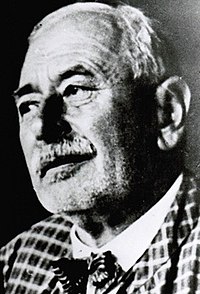Ernst Ritter von Lauda (born Ernst Philipp Johann Lauda, 15 August 1859 – 3 July 1932),[1] was an Austrian hydraulic and bridge engineer who was an adviser to Emperor Franz Joseph I of Austria. He was awarded the Order of Franz Joseph and the second class of the Order of the Iron Crown and was given his own coat of arms.
Ernst Lauda | |
|---|---|
 Photograph of Ernst Lauda | |
| Born | Ernst Philipp Johann Lauda 15 August 1859 |
| Died | 3 July 1932 (aged 72) Vienna, Austria |
| Nationality | Austrian |
| Other names | Ernst Ritter von Lauda |
| Education | Vienna University of Technology |
| Children | |
| Engineering career | |
| Discipline |
|
Personal life
editLauda was born on 15 August 1859 in Linz, Austria. His father Adolf Lauda, was a director of the Empress Elisabeth Railway. From 1876 to 1882, Lauda studied engineering at the Vienna University of Technology.[2] He was the father of physician Ernst Lauda and industrialist Hans Lauda, and the great-grandfather of Formula One world champion Niki Lauda.[1][2][3] Lauda died in 1932 in Vienna, Austria.[4]
Career
editLauda worked as a civil servant.[2] From 1881 to 1884, he worked on civil engineering and bridge construction.[2] He started out repairing the Stein-Mautern bridge that crosses the Danube river, as well as bridges across the Vltava river.[2]
In 1895, Lauda was appointed to the Board of Directors of the Hydrographic Central Office in Vienna. In 1909, Lauda became head of the hydraulic engineering department at the Ministry of Public Works.[2] In his role, he helped regulate the Danube river, which was prone to flooding.[5] Lauda blamed the flooding on increased deforestation around the Danube river, and the issue of deforestation around the Danube and the Seine were discussed at the 1909 International Congress of Navigation.[6] Ernst's great-grandson Niki Lauda said that Ernst's work on the Danube was the main reason why he was given heraldic honours.[7]
From 1915 to 1916, Lauda was President of the Austrian Association of Engineers and Architects, and from 1917 to 1918, he focused on repairing buildings damaged during the First World War. Lauda retired as an engineer in 1918, although he still gave occasional lectures at the Vienna University of Technology in the 1920s.[2]
Honours
editIn 1892, Lauda became a knight of the Order of Franz Joseph.[2] In 1914, he was awarded the second class of the Order of the Iron Crown.[2] In May 1916, Emperor Franz Joseph I of Austria promised Lauda his own coat of arms.[5] Franz Joseph I died a few months later, so the coat of arms was signed off by his successor, Charles I of Austria.[5] In 1917, Lauda also received a knighthood,[2][5] and an honorary doctorate from the Vienna University of Technology.[2][4]
References
edit- ^ a b Kerschbaumer, Arno (2017). Nobilitierungen unter der Regentschaft Kaiser Franz Joseph I. / I. Ferenc József király (1914–1916) (in German). Arno Kerschbaumer. pp. 253–255. ISBN 978-3-9504153-2-2.
- ^ a b c d e f g h i j k "Lauda, Ernst Ritter von (1859–1932), Wasserbau- und Brückenbautechniker" (in German). Österreichisches Biographisches Lexikon 1815–1950. 1 March 2011. Retrieved 9 May 2020.
- ^ Michel, Daniel (2019). Niki Lauda: Kleine Anekdoten aus dem Leben eines großen Rennfahrers (in German). Riva Verlag. ISBN 9783745308112.
- ^ a b Nagler, Josef (2013). Blätter für Technikgeschichte: Fünfzehntes Heft (in German). Springer-Verlag. p. 12. ISBN 9783709122914.
- ^ a b c d Kerschbaumer, Arno (2016). Arno Kerschbaumer: Nobilitierungen unter der Regentschaft Kaiser Karl I. / IV. Károly király (1916–1921) (in German). Arno Kerschbaumer. p. 74. ISBN 978-3-9504153-1-5.
- ^ United States Congressional Serial Set. Vol. 5384. U.S. Government Printing Office. 1909. pp. 11–12.
- ^ "Familie Lauda: Blaues Blut und rotes Kapperl". Kurier (in German). 23 May 2019. Retrieved 9 May 2020.